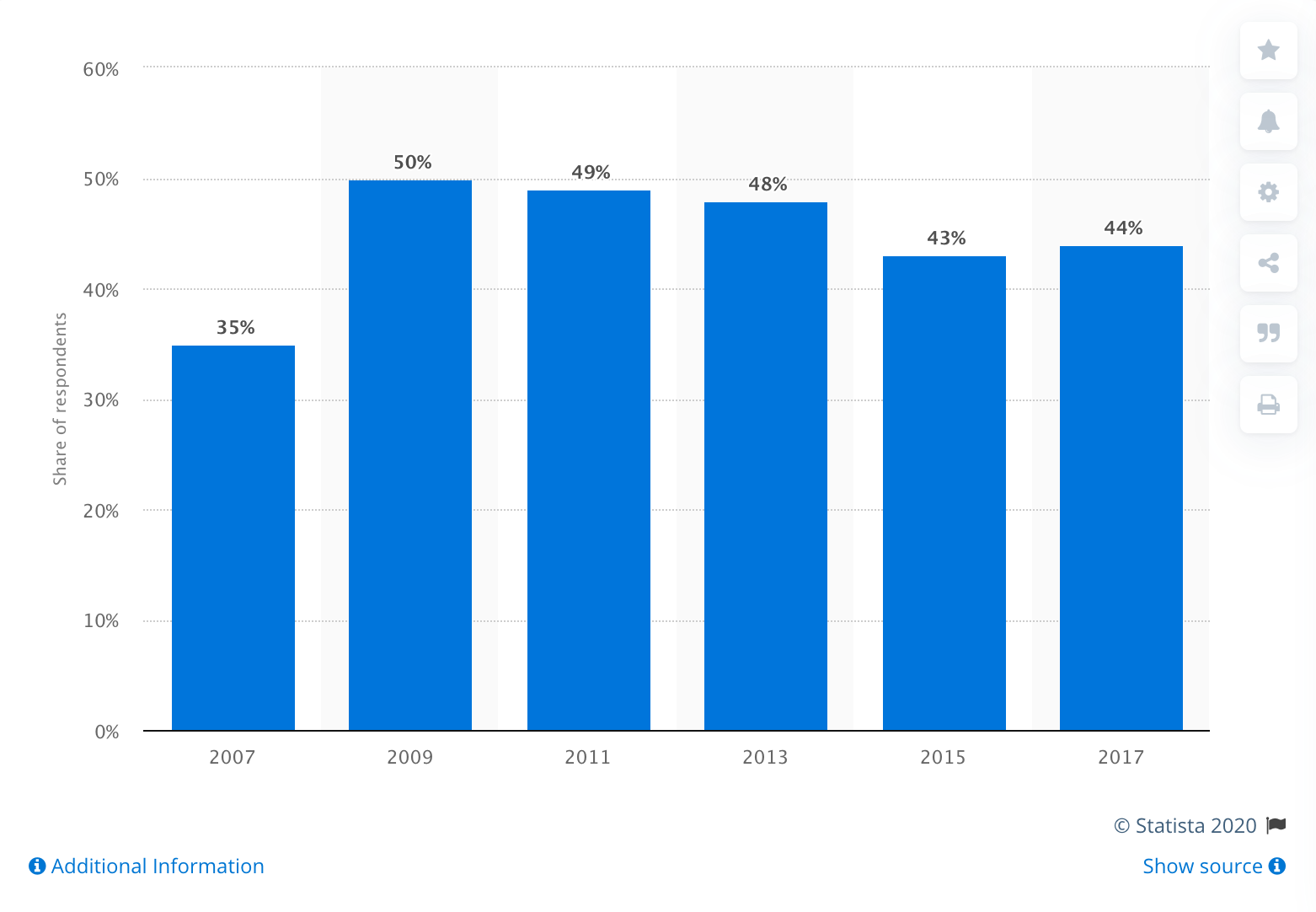When shopping, most people typically weigh up the price of a product to its value and make a purchasing decision based on the outcome. Essentially, that is consumerism. But what happens when we take into account the process of extracting raw materials, manufacturing, packaging, shelving, means of disposal and not to mention the usage of the profits to which our purchases contribute?
The moment we pause to think about what we buy and where we buy it from, we become conscious consumers. Along with price and value, consumers, on the whole, are becoming increasingly concerned with the social impact of the products they buy, from production to disposal.

(Chart showing a share of adults agreeing with the statement “I prefer to buy from companies that are aware of the impact of environmental issues” in the UK. Image: Statista)
Regular auto-pilot trips to the supermarket have been replaced with thoughtful considerations of the impact of products. For example, a consumer may consider where a chicken breast comes from, leading to how the chicken was raised and potentially question the impact of poultry farming on climate change- whilst making their purchasing decision. Another consumer may merely consider the price of the chicken breast with respect to its size or marinade.
It should be noted that many consumers will be interested in a products social impact as well as fair prices and good deals. These considerations aren’t mutually exclusive.
The rise of conscious consumerism: A brief history
The modern concept of “Dollar Voting” emerged in the 1950s as a component of individual participation in the economy and as a form of pure democracy in individual choice in the market. Essentially, it’s an analogy that considers every dollar spent as a vote for what consumers believe in.
Consumer movements of the late 19th and early 20th century advocated for consumer rights in industrialised countries like the UK and USA. They were in response to unfair labour conditions, to ensure product safety and encourage healthy competition in the markets.
Today, consumers have taken their rights and transformed what it means to be a paying customer by placing emphasis on making socially responsible consumer decisions. Technology has been a catalyst for the movement, as with a click of a button, consumers can research a product or brand and solicit advice on company ethics.
In short, the channels and speed through which we share information have drastically transformed the way consumers shop – online and in stores.
What drives conscious consumerism?
We know that consumers are more conscious, conscientious and knowledgeable when it comes to where they spend their money. Consumption is widely guided by where a product is made, how it’s made, and the materials it’s made from.
Being a conscious business means rethinking production, sourcing and delivery methods. It means ensuring each product delivers on the growing expectation for ethical, environmental and naturally sourced goods.
Above all, conscious consumers need a more meaningful connection with brands who care and who show it. Driving conscious consumer habits demands evidence of ethicality, sustainability and natural sources.
Ethicality
Consumers are more likely to make a purchase when they can make a positive impact during the purchasing process. In many cases, this can be as simple as supporting an ethical business.
One of the key drivers behind conscious consumer behaviour is the ability for consumers to use their individual actions to contribute to global impact. If a business has, as one of its objectives, to drive change in ann area that resonates with the consumer, their purchase is then a direct contribution to the shared cause.
Environmental sustainability
The past 10 years have seen a rise in public and consumer discourse over issues of environmental sustainability. A YouGov study from the Carbon Trust found that 55% of UK consumers said they feel much more than positive about a company that has reduced the carbon footprint of its products.
And it’s not all bad for company profits. According to the Nielsen Global Survey of Corporate Social Responsibility report; three out of four Millennials were willing to pay more for sustainable products. The same report found that 51% of Boomers were more inclined to pay more for sustainable products too.
Natural sources
Natural resources, whilst also contributing to a greener and more sustainable world, also have a positive impact on consumer behaviour. In the fast-paced digital world in which we live, there’s been a growing desire to switch off from it all and reconnect with what nature has to offer.
This desire has spurred consumers to adopt a more organic lifestyle. This group of consumers constitute the conscious millennials who are in pursuit of products that benefit their wellbeing as well that the wellbeing of the environment.
Retail brands like the Body Shop and Whole Foods have proven the demand for natural and organic produce. New businesses are cropping up all the time as we move into a more responsible consumer movement.
From aluminium-free deodorants and 100% natural ingredient cosmetics, the implementation of natural resources is only just beginning.
How can businesses promote this behaviour?
As consumers become more and more interested in the origins of the products they buy, companies should be focusing on providing their customers with ethical and sustainable products and services to satisfy this new generation of shopping.
Let’s consider how companies can implement effective strategies to promote conscious consumerism and generate a lasting positive movement towards a more sustainable and ethical world.
Different parts of a businesses strategy will be directly exposed to the consumer. What goes on behind the scene should be documented, reported and relayed to customers too. These elements can be published on company websites and blogs.
Whilst donating a percentage of each sale to charity, using eco-friendly materials and nurturing a positive relationship with all customers, is precisely what drives conscious consumers into the sales funnel, there’s more to be done.
Behind the scenes, conscious companies should be using ethical banks, connecting to power from green energy sources, promoting sustainable production and actively volunteering with charities. These pursuits may not be immediately visible to consumers but once noticed, will be warmly received.
Incorporating conscious consumerism into your business can be celebrated by participating in national and international awareness days. Let your consumers know that you’re a proud supporter of the causes that matter to them. These events also explore sustainable practices and offer advice on how best to implement them. The UN’s World Environment Day takes place yearly in June.
Aim to achieve recognition by the organisations that you want to be affiliated with, depending on the type of responsible consumerism you want to promote. For example, key organisations in the UK and worldwide offer certification on products.
Visual logos are sources of immediate recognition that prompt customers to trust the response to social responsibility. The Fairtrade Foundation’s logo represents products that have been sourced and traded sustainably. Cruelty-Free International’s leaping bunny logo tells customers that a product wasn’t tested on animals. And the Soil Association offers certification for products to carry the organic label.








